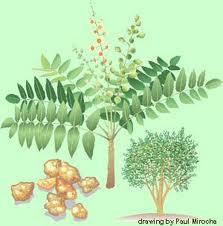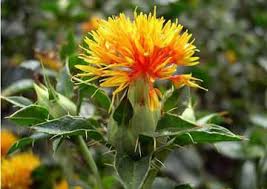Gentle Reader,
If you hesitate to take aspirin or other over the counter drugs for arthritis pain, you may be interested in anti-inflamatory plants as an alternatives Two plants have been used in the East for centuries. Their properties have been annalized and verified by Western medicine. Their potency has been standardized by a few companies and you can now take advantage of the age old usage to treat your own painful arthritis symptoms.
Boswellia serrata

Extracts of Boswellia serrata have been clinically studied for osteoarthritis and joint function, particularly for osteoarthritis of the knee. Positive effects of Boswellia in some chronic inflammatory diseases including rheumatoid arthritis, bronchial asthma, osteoarthritis, ulcerative colitis and Crohn’s disease have been reported. A Boswellia extract marketed under the name Wokvel has undergone human efficacy, comparative, pharmacokinetic studies. Some see Boswellia serrata as a promising alternative to NSAIDs, warranting further investigation in pharmacological studies and clinical trials. (from Wikipedia)
Boswellia is a tree found in India known for its gum resin which has many pharmacological uses, particularly as an anti-inflammatory. It’s also known as Indian frankincense, salai guggal, and boswellin. Its proper botanic name is boswellia serrata.
As a side note, the Biblical incense frankincense was probably an extract from the resin of the tree, boswellia sacra.
Boswellia has been used for thousands of years to treat many types of conditions. Recent research has determined many of the conditions were caused by inflammation.
Safflower flower
 Safflower is a highly-branched annual thistle-like herb that grows to a height of 3 feet producing yellow or reddish flowers. Each branch will usually have several flower heads containing 15-20 seeds per head. The dried flowers of the plant and its seeds are used commercially.
Safflower is a highly-branched annual thistle-like herb that grows to a height of 3 feet producing yellow or reddish flowers. Each branch will usually have several flower heads containing 15-20 seeds per head. The dried flowers of the plant and its seeds are used commercially.
Traditionally, safflowers were grown for their seeds and used for coloring foods and making red and yellow dyes. Its flowers can be used alone or in formulas. They can be prepared as dried powder, tinctures, or decoctions (extracts).
The oil from the seed has been used externally in therapeutic massage and as a natural alternative to mineral oil for use on babies. It’s also beneficial in applications for bruises, sprains and arthritis pain
Safflower is source of several flavonoids
More recently, the plant has been identified as the source of several flavonoids with strong antioxidant compounds.
Flavonoids are any of a group of oxygen-containing aromatic antioxidant compounds that includes many common pigments that help to lower inflammation as well as counteract the damaging effects of oxidation on body tissues.
The well-known antioxidant, guercetin, is one of the flavonoids found in safflower. Quercetin has many health benefits among which it can help reduce the inflammation that results from bursitis, gout, and arthritis.
Side effects
The safflower flower is often used in conjunction with herbs with no reported interactions. There are also no reported interactions of the extract or oil with standard pharmaceuticals.
Its use in dissolving clots, however, suggests that it should not be taken with blood-thinning treatments.
Safflower and boswellia combination effective for joint discomfort
Every day, many of us push ourselves to the limit both occupationally and recreationally. In the end, our bodies, and especially our joints, pay the price. Pain is the common symptom. It’s the body’s natural warning system and it deserves a natural response.
Safflower extract and boswellia extract are proven effective and safe for relief of arthritis pain, joint discomfort, and restricted knee flexion.
When combined in a natural product that contains a patent-pending blend of both extracts. it provides long-term relief within just a few weeks and is especially helpful for relieving chronic pain. Continued use of this natural product keeps pain away or markedly reduces pain daily. [thanks to Marty Saffell] Thanks to the anti-inflammatory plants Safflower and boswellia combination, so effective for joint discomfort
A web search for other herbs that are helpful with joint pain produced this anti-inflammatory triad:
Turmeric, ginger and bromelain work as effective anti-inflammatory agents. Each works to relieve pain, stiffness and swelling. In combination, they provide a powerhouse of natural medicine. The three substances are synergistic to one another, each boosting the other’s effectiveness… You can google products containing the three herbs together. I know of no clinical trials to substantiate these claims, nor can I vouch for standardization or purity of the herbs used.
Personally, I have been using the products Shaklee makes with Boswellia serrata and safflower flower extract for a number of years to manage my arthritis pain. I can recommend Pain Relief Complex without reservation. These Cox 2 and 5 Lox pain path inhibitors do no damage to the stomach, can be taken multiple times daily with no side effects whatsoever. It is a great relief to me to find an arthritis pain reliever that does not have any damaging side effects as I took a great deal of aspirin for years to try to kill the pain in my knees from early onset arthritis. I have no knee pain today. It is wonderful to have anti-inflammatory herbs to take.
Fondly,
Be Well, Do Well, Keep Moving
Betsy
Injured at 52. Diagnosed and sentenced to a wheel chair at 55. Hiking, skiing, dancing and walking at 77. Read my story.
206 933 1889 betsy@HiHoHealth.com www.GrandmaBetsyBell.com shopping ? www.hihohealth.com
